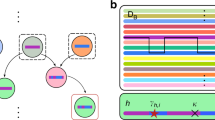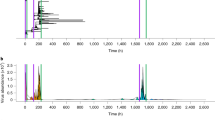Abstract
Using an experimental evolution approach, we recently demonstrated that the mouse-specific pathogen Friend virus (FV) complex adapted to specific major histocompatibility complex (MHC) genotypes, which resulted in fitness tradeoffs when viruses were exposed to hosts possessing novel MHC polymorphisms. Here we report the analysis of patterns of pathogen adaptation and virulence evolution from viruses adapting to one of three hosts that differ across the entire genome (A/WySn, DBA/2J and BALB/c). We found that serial passage of FV complex through these mouse genotypes resulted in significant increases in pathogen fitness (156-fold) and virulence (11-fold). Adaptive responses by post-passage viruses also resulted in host–genotype-specific patterns of adaptation. To evaluate the relative importance of MHC versus non-MHC polymorphisms as factors influencing pathogen adaptation and virulence, we compared the magnitude of fitness tradeoffs incurred by post-passage viruses when infecting hosts possessing either novel MHC polymorphisms alone or hosts possessing novel MHC and non-MHC polymorphisms. MHC polymorphisms alone accounted for 71% and 83% of the total observed reductions in viral fitness and virulence in unfamiliar host genotypes, respectively. Strikingly, these data suggest that genetic polymorphisms within the MHC, a gene region representing only ∼0.1% of the genome, are major host factors influencing pathogen adaptation and virulence evolution.
This is a preview of subscription content, access via your institution
Access options
Subscribe to this journal
Receive 6 digital issues and online access to articles
$119.00 per year
only $19.83 per issue
Buy this article
- Purchase on Springer Link
- Instant access to full article PDF
Prices may be subject to local taxes which are calculated during checkout




Similar content being viewed by others
References
Garrigan DHP . Perspective: detecting adaptive molecular polymorphism: lessons from the MHC. Evolution 2003; 57: 1707–1722.
Tiwari JL, Terasaki PI . HLA and disease associations 1 edn Springer-Verlag: New York, 1985.
Kubinak JL, Ruff JS, Hyzer CW, Slev PR, Potts WK . Experimental viral evolution to specific host MHC genotypes reveals fitness and virulence trade-offs in alternative MHC types. Proc Natl Acad Sci USA 2012; 109: 3422–3427.
Ruff JS, Nelson AC, Kubinak JL, Potts WK . MHC signaling during social communication. Adv Exp Med Biol 2012; 738: 290–313.
Apanius V, Penn D, Slev P, Ruff LR, Potts WK . The nature of selection on the major histocompatibility complex. Crit Rev Immunol 1997; 17: 179–224.
Potts WK, Slev PR . Pathogen-based models favoring MHC genetic diversity. Immunol Rev 1995; 143: 181–197.
Penn D, Potts W . The evolution of mating preferences and major histocompatibility genes. Am Nat 1999; 153: 145–164.
Eizaguirre C, Lenz TL, Kalbe M, Milinski M . Rapid and adaptive evolution of MHC genes under parasite selection in experimental vertebrate populations. Nat Commun 2012; 3: 621.
Murphy K . Janeway’s Immunobiology 8th edn Garland Science (Taylor and Francis, Inc.): New York, 2011.
Horst D, Verweij MC, Davison AJ, Ressing ME, Wiertz EJ . Viral evasion of T cell immunity: ancient mechanisms offering new applications. Curr Opin Immunol 2011; 23: 96–103.
Hosono S, Tai PC, Wang W, Ambrose M, Hwang DG, Yuan TT et al. Core antigen mutations of human hepatitis B virus in hepatomas accumulate in MHC class II-restricted T cell epitopes. Virology 1995; 212: 151–162.
Fernandez CS, Stratov I, De Rose R, Walsh K, Dale CJ, Smith MZ et al. Rapid viral escape at an immunodominant simian-human immunodeficiency virus cytotoxic T-lymphocyte epitope exacts a dramatic fitness cost. J Virol 2005; 79: 5721–5731.
Erickson AL, Kimura Y, Igarashi S, Eichelberger J, Houghton M, Sidney J et al. The outcome of hepatitis C virus infection is predicted by escape mutations in epitopes targeted by cytotoxic T lymphocytes. Immunity 2001; 15: 883–895.
Barouch DH, Kunstman J, Kuroda MJ, Schmitz JE, Santra S, Peyerl FW et al. Eventual AIDS vaccine failure in a rhesus monkey by viral escape from cytotoxic T lymphocytes. Nature 2002; 415: 335–339.
Allen TM, O’Connor DH, Jing P, Dzuris JL, Mothe BR, Vogel TU et al. Tat-specific cytotoxic T lymphocytes select for SIV escape variants during resolution of primary viraemia. Nature 2000; 407: 386–390.
O'Connor DH, Allen TM, Vogel TU, Jing P, DeSouza IP, Dodds E et al. Acute phase cytotoxic T lymphocyte escape is a hallmark of simian immunodeficiency virus infection. Nat Med 2002; 8: 493–499.
Goulder PJ, Brander C, Tang Y, Tremblay C, Colbert RA, Addo MM et al. Evolution and transmission of stable CTL escape mutations in HIV infection. Nature 2001; 412: 334–338.
Price DA, Goulder PJ, Klenerman P, Sewell AK, Easterbrook PJ, Troop M et al. Positive selection of HIV-1 cytotoxic T lymphocyte escape variants during primary infection. Proc Natl Acad Sci USA 1997; 94: 1890–1895.
Borrow P, Lewicki H, Wei X, Horwitz MS, Peffer N, Meyers H et al. Antiviral pressure exerted by HIV-1-specific cytotoxic T lymphocytes (CTLs) during primary infection demonstrated by rapid selection of CTL escape virus. Nat Med 1997; 3: 205–211.
Pewe L, Wu GF, Barnett EM, Castro RF, Perlman S . Cytotoxic T cell-resistant variants are selected in a virus-induced demyelinating disease. Immunity 1996; 5: 253–262.
Jones KE, Patel NG, Levy MA, Storeygard A, Balk D, Gittleman JL et al. Global trends in emerging infectious diseases. Nature 2008; 451: 990–993.
Daszak P, Cunningham AA, Hyatt AD . Emerging infectious diseases of wildlife—threats to biodiversity and human health. Science 2000; 287: 443–449.
Keesing F, Belden LK, Daszak P, Dobson A, Harvell CD, Holt RD et al. Impacts of biodiversity on the emergence and transmission of infectious diseases. Nature 2010; 468: 647–652.
Rohr JR, Dobson AP, Johnson PT, Kilpatrick AM, Paull SH, Raffel TR et al. Frontiers in climate change-disease research. Trends Ecol Evol 2011; 26: 270–277.
Altizer S, Harvell D, Friedle E . Rapid evolutionary dynamics and disease threats to biodiversity. Trends Ecol Evol 2003; 18: 589–596.
Hughes AL . MHC polymorphisms and the design of captive breeding programs. Conserv Biol 1991; 5: 249–251.
Miller PS, Hedrick PW . MHC polymorphisms and the design of captive breeding programs: simple solutions are not the answer. Conserv Biol 1991; 5: 556–558.
Vrijenhoek RC, Leberg PL . Let’s not throw the baby out with the bathwater: a comment on management for MHC diversity in captive populations. Conserv Biol 1991; 5: 252–254.
Friend C . Cell-free transmission in adult Swiss mice of a disease having the character of a leukemia. J Exp Med 1957; 105: 307–318.
Salvaudon L, Heraudet V, Shykoff JA . Genotype-specific interactions and the trade-off between host and parasite fitness. BMC Evol Biol 2007; 7: 189.
Grech K, Watt K, Read AF . Host-parasite interactions for virulence and resistance in a malaria model system. J Evol Biol 2006; 19: 1620–1630.
King KC, Lively CM . Does genetic diversity limit disease spread in natural host populations? Heredity 2012; 109: 199–203.
Pulkkinen K, Suomalainen LR, Read AF, Ebert D, Rintamaki P, Valtonen ET . Intensive fish farming and the evolution of pathogen virulence: the case of columnaris disease in Finland. Proc Biol Sci 2010; 277: 593–600.
Witter RL . Increased virulence of Marek’s disease virus field isolates. Avian Dis 1997; 41: 149–163.
McEwen SA, Fedorka-Cray PJ . Antimicrobial use and resistance in animals. Clin Infect Dis 2002; 34 (Suppl 3): S93–S106.
Angulo FJ, Nargund VN, Chiller TC . Evidence of an association between use of anti-microbial agents in food animals and anti-microbial resistance among bacteria isolated from humans and the human health consequences of such resistance. J Vet Med B Infect Dis Vet Public Health 2004; 51: 374–379.
Ney PA, D’Andrea AD . Friend erythroleukemia revisited. Blood 2000; 96: 3675–3680.
Yang H, Wang JR, Didion JP, Buus RJ, Bell TA, Welsh CE et al. Subspecific origin and haplotype diversity in the laboratory mouse. Nat Genet 2011; 43: 648–655.
Sage RD . Wild Mice. In: Foster HL, Small JD, Fox JG eds The mouse in biomedical research; 1. Academic Press: NY, 1981, pp 40–90.
Wade CM, Kulbokas EJ 3rd, Kirby AW, Zody MC, Mullikin JC, Lander ES et al. The mosaic structure of variation in the laboratory mouse genome. Nature 2002; 420: 574–578.
Li JP, D’Andrea AD, Lodish HF, Baltimore D . Activation of cell growth by binding of Friend spleen focus-forming virus gp55 glycoprotein to the erythropoietin receptor. Nature 1990; 343: 762–764.
Metcalf D, Furth J, Buffett RF . Pathogenesis of mouse leukemia caused by Friend virus. Cancer Res 1959; 19: 52–58.
Acknowledgements
This work was supported by National Science Foundation Grant DEB 0918969 (to WKP and Dr Fred Adler); National Science Foundation Doctoral Dissertation Improvement Grant DEB 0910052 (to JLK and WKP); and National Science Foundation Educational Outreach Grant DGE 08-41233 (to JLK and JSR). We thank Dr Sandra Ruscetti for her useful insights regarding FV complex as well as her generous provision of reagents throughout these experiments. We also thank Linda Morrison for her help in the design and optimization of assays. Finally, we thank two anonymous reviewers for their constructive comments during manuscript preparation.
Author information
Authors and Affiliations
Corresponding author
Ethics declarations
Competing interests
The authors declare no conflict of interest.
Additional information
Supplementary Information accompanies this paper on Genes and Immunity website
Supplementary information
Rights and permissions
About this article
Cite this article
Kubinak, J., Ruff, J., Cornwall, D. et al. Experimental viral evolution reveals major histocompatibility complex polymorphisms as the primary host factors controlling pathogen adaptation and virulence. Genes Immun 14, 365–372 (2013). https://doi.org/10.1038/gene.2013.27
Received:
Revised:
Accepted:
Published:
Issue Date:
DOI: https://doi.org/10.1038/gene.2013.27
Keywords
This article is cited by
-
Host–parasite co-evolution and its genomic signature
Nature Reviews Genetics (2020)
-
Differences can hold populations together
Nature (2017)
-
High adaptive variability and virus-driven selection on major histocompatibility complex (MHC) genes in invasive wild rabbits in Australia
Biological Invasions (2017)



